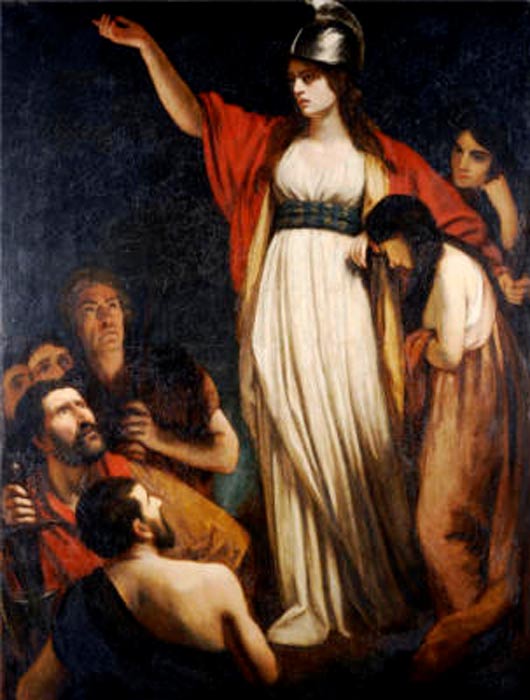
Romans, quaking in their Sandals After an Attack by Boudica, built a Massive Fort to Defend London
Around 60 AD Queen Boudica of the Iceni (a Celtic clan) attacked and razed London, a Roman city of ancient Britain. Now, researchers have just announced that in response to Boudica and her warriors’ wild revolution, the terrified and shamed Romans built a fort with ditches 10 feet (3.05 meters) deep, walls 10 feet high, palisades, and a platform from which to repel attacks.
Boudica (also spelt Boudicca and Boadicea) was an imposing, even terrifying sight, according to the Roman historian Cassius Dio, who described her and the destruction her forces wrought:
“...a terrible disaster occurred in Britain. Two cities were sacked, eighty thousand of the Romans and of their allies perished, and the island was lost to Rome. Moreover, all this ruin was brought upon the Romans by a woman, a fact which in itself caused them the greatest shame....But the person who was chiefly instrumental in rousing the natives and persuading them to fight the Romans, the person who was thought worthy to be their leader and who directed the conduct of the entire war, was Buduica, a Briton woman of the royal family and possessed of greater intelligence than often belongs to women....In stature she was very tall, in appearance most terrifying, in the glance of her eye most fierce, and her voice was harsh; a great mass of the tawniest hair fell to her hips; around her neck was a large golden necklace; and she wore a tunic of diverse colours over which a thick mantle was fastened with a brooch. This was her invariable attire.”

The Snettisham Torc (a golden necklace) like one Boudica might have worn. (U. of Chicago)
No wonder the terrified Romans built such a massive fort.
“Positioned over the main road into London, commanding the route into the town from London Bridge and overlooking the river, the fort would have dominated the town at this time, perhaps reflecting the absence of civilian life and the utter destruction wrought by the native Britons on Roman London,” says the Museum of London Archaeology in a short article.
- Boudicca, the Celtic Queen that unleashed fury on the Romans
- Is Celtic Birdlip Grave the Final Resting Place of Queen Boudicca?
The British government, in excavations at Plantation Palace on Fenchurch Street, uncovered the wooden and earthwork fort, which covered 3.7 acres. It measured 3 meters (9.84 ft.) high and was reinforced with growing turf and interlacing timbers. There was a fighting platform with palisade and towers at the gateway on the top of the bank.
For extra protection, the fort was enclosed by double ditches, 1.9 (6.2 feet) meters wide and 3 meters (9.84 ft.) deep. A press release from the Museum of London Archaeology (MOLA) called the ditches “an impressive obstacle for would be attackers.”

Reconstruction of a Roman defensive position. (MOLA)
Apparently, the fort was a temporary, emergency structure that was not meant to be occupied long-term and was used to re-establish and reconstruct the important trading post. MOLA says researchers found evidence of tent use in the fort as opposed to permanent barracks. It was in use for only 10 years.
Julian Hill, Roman London Expert at MOLA, said in a press release: “The discovery of this early Roman fort provides precious new information about how the Romans re-established control of Britain following Boudica’s damaging blow. It also demonstrates the strategic importance of London at this time.”

‘Boadicea Haranguing the Britons’ by John Opie. (Public Domain)
The museum’s website about the find states:
“The Roman army were experts in construction; proficiently sourcing local materials from nearby woods and even using debris from buildings burnt in the revolt. It is estimated that a fort of this size would have housed a cohort of approximately 500 men but could have been built by hand in a matter of weeks, perhaps with the help of captive Britons. Archaeologists uncovered a pick axe and a hammer, tools that would have been available to the army for building projects.”
- Tomoe Gozen - A fearsome Japanese Female Warrior of the 12th Century
- Metal detectorist uncovers Roman treasure hoard in England
The fort had roads, storage and administrative facilities, a cookhouse, a granary, and a latrine. Very few artifacts were found, though archaeologists did turn up part of a helmet and some mounts from horse harnesses.

Militaria from Plantation Place Roman fort. (MOLA)
“A number of major infrastructure projects contemporary with the fort point to the army playing a crucial role in this rebuilding, providing labour and engineering expertise for roads, a new quay and a water lifting machine, all vital for trading and civilian life to thrive once again,” the article states.
About 60 years after Boudica’s attack, the Romans built Cripplegate fort, then in the 3rd century a big wall was built around London. Archaeologists are searching for forts or other defensive structures from the intervening periods.

Timber lacework from vallum of the fort. (MOLA)
Featured Image: Reconstruction of Plantation Place Fort. Source: MOLA
By Mark Miller















